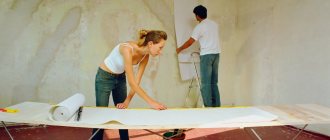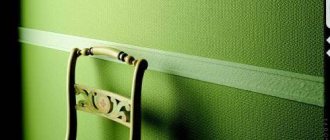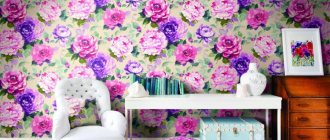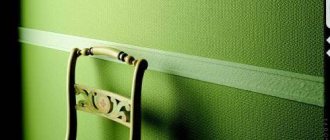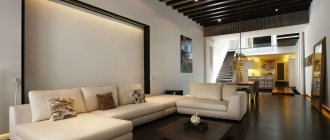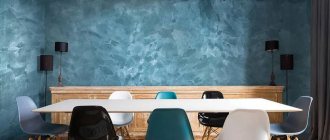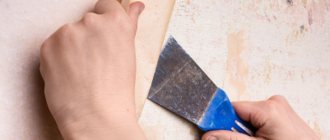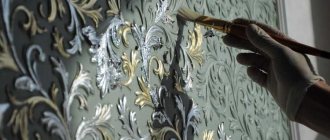The secret of popularity is simple - natural wallpapers are environmentally friendly, safe, durable, do not put a strain on the consumer’s wallet and are simply irreplaceable for bold experiments with the visual part of the interior:
They are made from parts of plant crops and carry the enchanting energy of living nature. Wallpaper fits perfectly into any layout and style of the room, and has a wide range of colors and surface textures:
Sometimes they decorate only one wall in a room , and for the rest they select another material, for example, wooden panels, paint, plaster, or another type of wallpaper. This solution allows you to divide a room into separate zones and is actively used by professional designers:
Natural wallpaper does not have to be used to cover the entire area ; they can be successfully used to decorate individual fragments of the interior. 1/3 is covered with decor ; inserts in the form of squares, rectangles or complex geometric shapes are also made.
What are natural wallpapers?
Manufacturers of natural finishing materials know that to implement modern design projects, a wide range of products is needed. Therefore, products of several categories enter the market. Let's take a closer look at them.
Bamboo wallpaper
Bamboo wallpaper was the first to appear on the market. The standard roll length is 14 m, and the width varies from 0.9 to 2 m. The canvas can be: varnished , without varnish , stitched . Initially, the products were made only in natural and cognac brandy , lime , and rosewood appeared . The latest novelty is tortoiseshell canvas:
The width of the stripes varies. For walls, rolls are made on a fabric basis , they are mounted on the ceiling , used for niches in the wall, columns , and finishing loggias . Canvases and bamboo panels are used for upholstering furniture:
The material, made only from bamboo slats , looks impressive. In the interior it is better to use a combination of several plant materials : reed , papyrus and others. Such wallpapers are easier to glue than those that consist only of bamboo, since they are quite light.
We invite you to watch a video with instructions for sticking natural bamboo wallpaper:
If the canvas is fixed on the walls in the form of small fragments , you can add bamboo parquet or flooring . When the walls in the room are completely covered with wallpaper, it is better to use another material for the floor, for example cork - it is also natural.
Natural wallpaper-leaves
Modern natural materials include leaf wallpaper . This is a completely new type of decor. Leaves of different plants are glued onto a paper base. The width of a standard roll is 0.9 m, length is 10 m. Example in the photo:
These wallpapers look very original and elegant . In their production, colorful leaves are used. The only drawback is that the canvases are quite fragile.
It is better full-wall solutions where there are children and animals due to the risk of damage.
Cork wallpaper
In addition to cork panels, there are natural wallpapers for walls made from this material. They are much lighter and easier to handle. Indispensable for people with an acute reaction of the immune system to allergens.
Wallpaper with veneer
Veneer is a very thin layer of wood up to 0.8 mm thick. The same workpiece can produce different textures, depending on the cutting and gluing technology. An array of valuable species is used to make wallpaper. It can be oak , cherry , sandalwood , wenge and others. If the veneer is light, it is applied to a paper base; if it is heavy, it is applied to a non-woven base:
“Wooden” wallpaper has already gained popularity in the category of natural materials. They have a paper base and veneer on top. Self-adhesive products have recently appeared on the market.
Wallpaper made of silk, velvet and leather
Not the most common, but visually chic option for interior decoration. Can be used for offices in sober colors and rooms designed in a business, classic style.
High cost of wallpaper made from natural materials
A significant disadvantage of natural wallpaper is its high cost. But this is not surprising when you consider that the production of this wallpaper uses a lot of manual labor, not only unskilled labor, but also the labor of real craftsmen. Before you start making wallpaper, plant materials for their production are collected and dried in a certain way so that they do not lose their natural colors. Next, the master comes up with a design or tinting of the wallpaper, collects a sample, and only then on special machines does the connection of plant fibers, blades of grass, and threads take place. This process is somewhat similar to creating a painting. Subsequently, this natural canvas is applied to a paper, non-woven or fabric base. Therefore, natural wallpaper, by definition, cannot be cheap.
Advantages and disadvantages of natural wallpaper
The undoubted advantages include the following factors:
- Great appearance . Natural materials blend harmoniously with any interior.
- Durability . , natural products last 5-10 years without restoration.
- Easy pasting . The process is no different from what is typical for traditional wallpaper.
- Good insulation . Cork retains heat well and dampens extraneous noise.
Of course, there are also disadvantages , for example:
- Wallpaper absorbs smell well . They should be used with caution in the kitchen or in smoking areas.
- Fragile structure . Leaves glued to a paper base, veneer - all this can easily be damaged by a child, a domestic cat or dog.
If there are animals in the house , it is better to glue natural canvas at a distance of 60-80 cm from the floor.
Useful qualities of natural wallpaper
- Of course, the main quality of natural wallpaper is that it is environmentally friendly and does not have a harmful effect on the body. The material from which they are made is natural, so it’s even easier to breathe in a room covered with natural wallpaper.
- Their color and texture have absorbed all the variety of colors of nature, even the eyes do not get tired when contemplating this natural beauty contained in the wallpaper.
- In addition, a lot of manual labor goes into the production of natural wallpaper. Therefore, in addition to the beneficial natural effects, natural wallpapers carry a positive aura of the craftsman who creates this finishing material.
- Air exchange and redistribution of humidity in a room covered with natural wallpaper occurs naturally.
- This wallpaper absorbs noise.
- Natural wallpapers are not susceptible to the harmful effects of the external environment: they do not grow fungus, they do not fade, do not become damp in humid air, and are not affected by insects.
- Even with prolonged use, they do not change their appearance, they also look fresh and attractive.
How to properly apply natural wallpaper: useful tips
Let's give some useful tips that will come in handy when gluing wallpaper from natural materials:
- The canvas can be cut across with a regular knife , and along with metal scissors.
- Before starting work, the roll should be unrolled and allowed to “rest” so that the material adapts to the indoor climate.
- No need to paste wallpaper over old ones . It is better to properly prepare and prime the walls.
- It is necessary to choose the right combination of shades . For natural wallpaper, only a slight deviation of the color scheme from the main one is permissible.
- For gluing, regular universal wallpaper adhesive or a compound for vinyl materials is suitable.
- Be careful when handling glue . The front surface should be protected as much as possible from its contact.
- When working with heavy canvases (roll weight more than 3 kg with a length of 10 m), it is worth applying an additional layer of glue.
- The first strip of wallpaper is always glued “ from the light ” (from the window), strictly maintaining verticality using a plumb line or level.
- At the window, the canvas is glued so that the edge protrudes by 1-3 cm . Next, the edge is bent, forming a break, and carefully cut to the required size.
Before starting work, switches and sockets must be dismantled, and then holes of the required shape are cut for them.
Natural wallpaper in the interior: photos and videos
First, let's show a video that shows a corridor made of natural wallpaper in Japanese style:
Natural materials can be used to decorate any room. For example, here is a good photo of the living room :
Natural textures have a calming effect on household members, so they look perfect in a bedroom :
Nothing prevents you from adding variety to your kitchen . The combination of plain walls and floors looks especially advantageous:
The hallway should not be left idle ; guests pay attention to this room first of all:
At the end of our article, we suggest watching a video in which experts talk in detail about the features of natural wallpaper:
In addition to natural finishing materials, there are artificial ones. They also look great on the walls of the room. For example: look at the photo of silk plaster in the interior of modern apartments.


